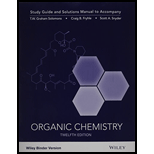
Organic Chemistry, 12e Binder Ready Version Study Guide / Student Solutions Manual
12th Edition
ISBN: 9781119077336
Author: T. W. Graham Solomons, Craig B. Fryhle, Scott A. Snyder
Publisher: WILEY
expand_more
expand_more
format_list_bulleted
Concept explainers
Question
Chapter 1, Problem 4PP
Interpretation Introduction
Interpretation:
It is to be decided whether the bond in each of the given compound is ionic or covalent.
Concept introduction:
A chemical bond in the Lewis model illustrates the sharing or transfer of valence electrons to acquire a stable configuration (octet) for the bonding atoms.
While forming
In general, bond between a metal and nonmetal is ionic in nature and bond between two nonmetal atoms is covalent in nature.
Expert Solution & Answer
Learn your wayIncludes step-by-step video

schedule05:45
Students have asked these similar questions
Write an equation to show the reaction between ethanol, C2H5OH and methyllithium, CH3 Draw all non-bonding electrons and show electron flow with curved arrows.
All presented compounds contain oxygen atom in their structure. What is the formal charge on oxygen atom in each compound?
PLEASE SOLVE FOR G, H, and I.
Problem Name each of the following anions and give the name and formula of the acid derived from it: (a) Br-; (b) IO3 -; (c) CN-; (d) SO4 2-; (e) NO2 -.
Chapter 1 Solutions
Organic Chemistry, 12e Binder Ready Version Study Guide / Student Solutions Manual
Ch. 1 - Prob. 1PPCh. 1 - Prob. 2PPCh. 1 - Prob. 3PPCh. 1 - Prob. 4PPCh. 1 - Prob. 5PPCh. 1 - Prob. 6PPCh. 1 - Prob. 7PPCh. 1 - Prob. 8PPCh. 1 - Prob. 9PPCh. 1 - Prob. 10PP
Ch. 1 - Prob. 11PPCh. 1 - Prob. 12PPCh. 1 - Prob. 13PPCh. 1 - Prob. 14PPCh. 1 - Prob. 15PPCh. 1 - Prob. 16PPCh. 1 - Prob. 17PPCh. 1 - Prob. 18PPCh. 1 - Prob. 19PPCh. 1 - Prob. 20PPCh. 1 - Prob. 21PPCh. 1 - Practice Problem 1.22 Which of the following...Ch. 1 - Prob. 23PPCh. 1 - Prob. 24PPCh. 1 - Practice Problem 1.25
What do the bond angles of...Ch. 1 - Prob. 26PPCh. 1 - Practice Problem 1.27
Use VSEPR theory to predict...Ch. 1 - Practice Problem 1.28 Predict the bond angles of...Ch. 1 - 1.29 Which of the following ions possess the...Ch. 1 - 1.30 Write a Lewis structure for each of the...Ch. 1 - Prob. 31PCh. 1 - Add any unshared electrons to give each element an...Ch. 1 - Prob. 33PCh. 1 - What is the molecular formula for each of the...Ch. 1 - Prob. 35PCh. 1 - Prob. 36PCh. 1 - 1.37 Write bond-line formulas for all of the...Ch. 1 - Prob. 38PCh. 1 - Prob. 39PCh. 1 - Prob. 40PCh. 1 - Prob. 41PCh. 1 - (a) Cyanic acid (HOCN) and isocyanic acid (HN=C=O)...Ch. 1 - Consider a chemical species (either a molecule or...Ch. 1 - 1.44 Consider a chemical species like the one in...Ch. 1 - 1.45 Consider another chemical species like the...Ch. 1 - Draw a three-dimensional orbital representation...Ch. 1 - Ozone (O3) is found in the upper atmosphere where...Ch. 1 - Write resonance structures for the azide ion, N3....Ch. 1 - Write structural formulas of the type indicated:...Ch. 1 - Prob. 50PCh. 1 - 1.51 In Chapter 15 we shall learn how the...Ch. 1 - Prob. 52PCh. 1 - (a) Consider a carbon atom in its ground state....Ch. 1 - Open computer molecular models for dimethyl ether,...Ch. 1 - Boron is a group IIIA element. Open the molecular...Ch. 1 - 1.56 There are two contributing resonance...Ch. 1 - Prob. 1LGPCh. 1 - Consider the compound with the following condensed...Ch. 1 - Consider the compound with the following condensed...Ch. 1 - Consider the compound with the following condensed...Ch. 1 - Consider the compound with the following condensed...Ch. 1 - Consider the compound with the following condensed...Ch. 1 - Prob. 7LGPCh. 1 - Prob. 8LGP
Knowledge Booster
Learn more about
Need a deep-dive on the concept behind this application? Look no further. Learn more about this topic, chemistry and related others by exploring similar questions and additional content below.Similar questions
- For the compound below draw all resonance structures that are possible. Make sure to include formal charges, curved arrows (to show electron flow), and all electron pairs.arrow_forwardDraw the bond-line formula for the given compounds. am i correct? if not, what are the right bond-line formulas?arrow_forwardHomework problem wants to different structures that have the same molecular formula but different connectivities for c5h12arrow_forward
- Supply a molecular formula structure for the compound shown herearrow_forwardDetermine a molecular formula, e.g. , from the line structure below.Specify elements in the following order: , , others(in alphabetical order).parts 7 and 8arrow_forwardDraw a skeletal structure for the molecules in parts (a) and (b), and a condensed structure for the molecules in parts (c) and (d)arrow_forward
- Consider the following three molecules, A-C:arrow_forwardB. IsomersFor each of the following molecules, draw the complete structural formula (show all bonds) and the condensed formula. B.1 B.2arrow_forwardGiven this information, what are the 2 compounds? (Second image has a molecular formula of c4h8o2)arrow_forward
- Draw the major resonance structure for the compound shown; include lone pairs of electrons, formal charges, and condensed hydrogen atoms (located in the More menu). Then draw curved arrows to show how this can be converted to the Lewis structure givenarrow_forwardWhich of these statements correctly describes the relationship between the displayed molecules? -Only one of these represents a valid Lewis Structure -They do not have the same molecular formula -They are isomers -They are the same moleculearrow_forwardQuestion: The vanillin molecule depicted below is a flavor in vanilla beans. What is the molecular formula for this molecule? Also, consider the bonds indicated with arrows below. What types of covalent bonds are these? What types of orbitals overlap to make each of these bonds?arrow_forward
arrow_back_ios
SEE MORE QUESTIONS
arrow_forward_ios
Recommended textbooks for you
 Organic Chemistry: A Guided InquiryChemistryISBN:9780618974122Author:Andrei StraumanisPublisher:Cengage Learning
Organic Chemistry: A Guided InquiryChemistryISBN:9780618974122Author:Andrei StraumanisPublisher:Cengage Learning

Organic Chemistry: A Guided Inquiry
Chemistry
ISBN:9780618974122
Author:Andrei Straumanis
Publisher:Cengage Learning